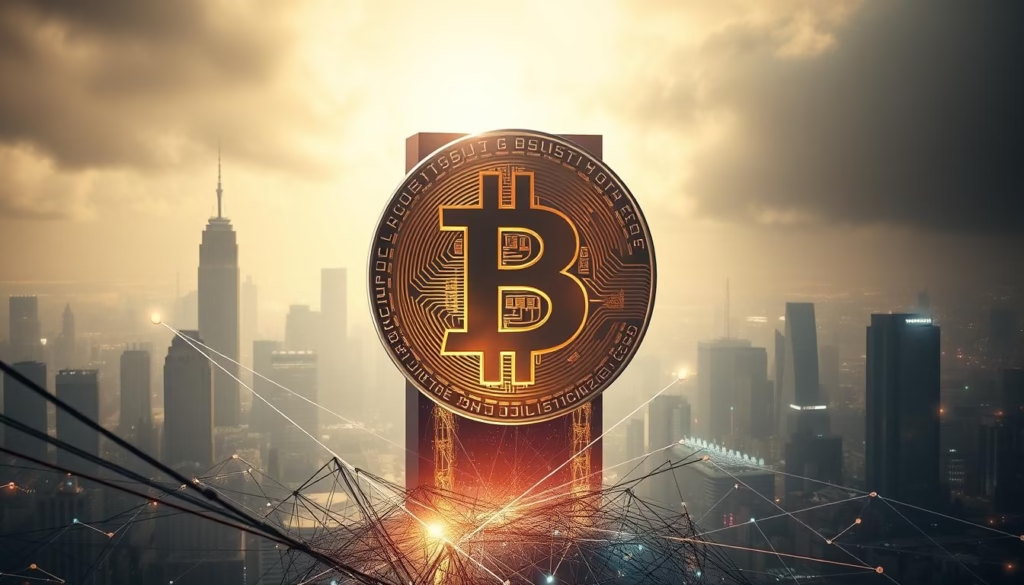Bitcoin has changed the way we think about money. It started in 2008 and has made big waves in finance. This study looks at how Bitcoin works and its big impact on the world.
It shows how Bitcoin changed how we do business and invest. It also talks about how it affects money policies.
The Origins and Evolution of Bitcoin
In 2008, someone named Satoshi Nakamoto shared the bitcoin whitepaper. This paper changed how we think about money. It talked about a new way to send money without needing banks.
Satoshi Nakamoto and the 2008 Whitepaper
The bitcoin whitepaper explained a new network. It solved a big problem with money. Satoshi’s true name is still a mystery, but their ideas were very interesting.
A key part of the paper said,
“We propose a solution to the double-spending problem using a peer-to-peer distributed timestamp server.”
This idea started a new way of agreeing on things without a boss.
The First Bitcoin Transaction
In 2010, a programmer named Laszlo Hanyecz bought two pizzas with 10,000 BTC. This event is called Bitcoin Pizza Day. It showed that Bitcoin could be used to buy real things.
Early Adoption and Growth (2009–2013)
People like Hal Finney tested Bitcoin early on. Places like Mt. Gox became big places to buy and sell Bitcoin. By 2013, Bitcoin’s value went up to $1,000. This showed that more people were starting to use it.
| Year | Event |
|---|---|
| 2009 | Genesis Block mined with embedded Times headline |
| 2010 | First pizza purchase (10,000 BTC) |
| 2013 | Price reaches $1,000 for the first time |
These steps made Bitcoin real and important. It started to grow and become known worldwide.
Understanding Bitcoin’s Technical Framework
Bitcoin uses special technologies to make it safe and unique. These technologies work together. They create a network that is open and fair, without one person in charge.
Blockchain Technology Explained
The bitcoin blockchain is like a book that never changes. It keeps track of every Bitcoin transaction. Each page links to the one before it, making it hard to change.
This makes everything clear but keeps your personal info safe.
| Feature | Description |
|---|---|
| Decentralization | No single entity controls the network |
| Immutability | Blocks cannot be altered once verified |
| Transparency | All transactions are publicly visible |
Mining Process and Consensus Mechanisms
Cryptocurrency mining is what makes Bitcoin work. Miners try to solve puzzles to add new blocks. This keeps the network safe and rewards miners with new Bitcoins.

- Miners solve complex mathematical problems
- Blocks are added every 10 minutes
- Rewards decrease during bitcoin halving events
Security Features and Cryptographic Foundations
Cryptographic security is key to Bitcoin’s safety. It uses special math to protect transactions. Changing one transaction would make it hard to keep the network safe.
Bitcoin’s Supply Limitations and Halving Events
Bitcoin has a limit of 21 million coins. Every four years, bitcoin halving cuts the reward for miners in half. This makes Bitcoin like gold, not like money that can be printed.
| Halving Date | Reward Reduction |
|---|---|
| 2012-2016 | 50 BTC → 25 BTC |
| 2020 | 12.5 BTC → 6.25 BTC |
| 2024 | Next halving expected |
These parts work together to make Bitcoin special. They help it be a fair, open money system.
Bitcoin as a Financial Revolution

Bitcoin has changed how we think about money. It’s not like old money systems. It’s different because it’s not controlled by banks.
Bitcoin has only 21 million units. This is different from old money that can be made more easily.
| Feature | Bitcoin | Fiat Currency |
|---|---|---|
| Supply | Fixed at 21M | Unlimited printing |
| Control | Decentralized network | Government-regulated |
| Inflation Resistance | Programmed scarcity | Dependent on policy |
Bitcoin is seen as digital gold. It’s more valuable than real gold in some ways. Over 100 million people worldwide use Bitcoin.
Since 2020, more big companies are using Bitcoin. This shows it’s becoming more popular.
- Market cap exceeded $1T in 2020, reaching $1.2T in 2023
- Adoption in unbanked regions: 25% of users in Africa rely on crypto for cross-border payments
- Price volatility dropped 30% since 2017 as adoption grew
Bitcoin represents the first non-state monetary system in history,” says blockchain analyst Tone Vays.
Some people say Bitcoin uses too much energy. They also worry about its price going up and down. But others think it’s safer than old money.
Bitcoin is getting into new areas like ETFs and company money. This debate is changing how we think about money. The world of money is always changing with Bitcoin.
Global Impact and Adoption Patterns of Bitcoin

Bitcoin is growing in many ways. Companies like MicroStrategy and Tesla are using Bitcoin. They see it as a safe choice.
PayPal and Fidelity are also getting into crypto. They want to mix old money ways with new digital ones.
Institutional Investment Trends
MicroStrategy has over 130,000 Bitcoin. They think it’s a smart move against inflation. Tesla bought $1.5 billion worth of Bitcoin in 2021.
These big moves show Bitcoin is becoming more important. It’s moving from a special thing to a big part of finance.
Geographic Distribution of Bitcoin Usage
Nigeria loves Bitcoin, with 18 million users. They use it to get around money rules. Vietnam and the Philippines also use it a lot for sending money.
El Salvador made Bitcoin legal in 2021. This was a big step. But, Bitcoin’s price can change a lot.
“Bitcoin is the future of money,” said El Salvador’s President Nayib Bukele. But, its price changes can be a problem.
Regulatory Responses Across Jurisdictions
How countries see Bitcoin is different. China banned mining in 2021. This moved operations to places like Kazakhstan.
Switzerland is welcoming to crypto. It has rules that attract big companies. Here’s how different places handle Bitcoin:
| Region | Regulatory Approach | Adoption Impact |
|---|---|---|
| El Salvador | Legal tender status | Merchant adoption rose 30%, but price swings cause uncertainty |
| China | Strict mining bans | Global hash rate shifted 90% out of China |
| US/EU | Ongoing crypto regulatory framework debates | Slow institutional adoption amid uncertainty |
Bitcoin’s future depends on good rules. Governments must choose to help or stop it. Its use is growing, but not evenly.
Challenges and Criticisms Facing the Bitcoin Ecosystem
Bitcoin’s rise has sparked debates over its energy use and environmental impact. Critics say its proof-of-work system strains energy grids. But, advocates point to mining hubs like Sichuan, China, using renewable energy.
A 2023 Cambridge study found 56% of mining now uses sustainable sources. This shows progress in making mining greener.

“Price swings reflect cryptocurrency volatility, complicating Bitcoin’s role as a stable store of value.”
Market instability is a big hurdle. Wild price swings make Bitcoin risky for everyday use. In 2022, prices swung 80% in a month, scaring off merchants.
Bitcoin also struggles with scalability. Peak usage causes delays and fees over $50 in 2021. But, layer-two networks like the Lightning Network now handle 2,000+ transactions per second.
Security risks are still there. Crypto security concerns include exchange breaches and vulnerabilities to quantum computing. While Bitcoin’s core protocol is safe, user errors cause 30% of thefts since 2010.
| Challenge | Response |
|---|---|
| High energy use | Transition to renewables, R&D for greener consensus models |
| Price swings | Institutional adoption for market stabilization |
| Transaction bottlenecks | Layer-2 scaling solutions |
Fixing these issues needs teamwork from developers, regulators, and users. Finding a balance between innovation and sustainability will shape Bitcoin’s future.
Conclusion: Bitcoin’s Legacy and Future Prospects
Bitcoin started as a 2008 idea and grew into a trillion-dollar asset. Now, it’s all about making it better with new tech like the Lightning Network. These updates could make it easier and faster to use, helping it grow even more.
Bitcoin has changed the world of money, inspiring many new projects. Its journey shows how digital money can work. It’s a big deal for the future of money.
Bitcoin’s future depends on big players and clear rules. People argue if it should be like gold or something new. But, Bitcoin’s special because it’s not controlled by anyone.
It started a new way of thinking about money and trust. Bitcoin’s story shows digital money can work. It’s changed how we see money forever.
FAQ
What is Bitcoin?
Bitcoin is a new kind of money. It’s the first digital currency that doesn’t need a bank. It uses special technology called blockchain to keep things safe and clear.
How does Bitcoin mining work?
Mining Bitcoin uses super-fast computers. They solve hard math problems to check transactions. Miners also get new coins and fees for their work.
What are the benefits of using Bitcoin compared to traditional currencies?
Bitcoin is better because it’s hard to control and has low fees. You can send money across the world without banks. Plus, it won’t run out because there’s a limit to how much there is.
What are Bitcoin halving events?
Halving events cut the reward for mining in half every four years. This keeps the number of coins limited. It helps make Bitcoin more valuable over time.
How has Bitcoin’s adoption evolved globally?
More people around the world are using Bitcoin. Big companies like MicroStrategy and Tesla are investing. Countries like Nigeria and Vietnam use it for sending money and getting access to money.
What are the main challenges facing Bitcoin today?
Bitcoin faces issues like using a lot of energy and being very volatile. It can’t handle many transactions at once. Also, rules about Bitcoin vary by country.
How does Bitcoin function as a store of value?
Bitcoin is seen as a digital gold. It’s a safe place to put money because there’s only so much of it. People use it as a protection against losing money value.
What role do institutions play in Bitcoin’s market?
Big players are now using Bitcoin. They add it to their money and offer services. This makes Bitcoin more accepted and attractive to more people.
How does Bitcoin differ from other cryptocurrencies?
Bitcoin is special because it was first. It’s well-known and has a strong market. Other coins try to do different things, but Bitcoin is still the most recognized.
